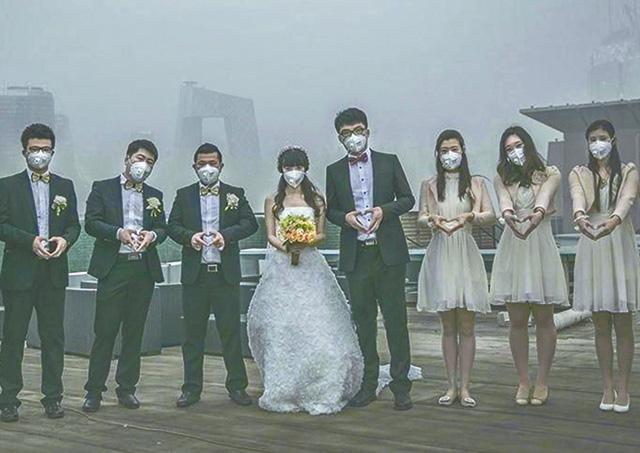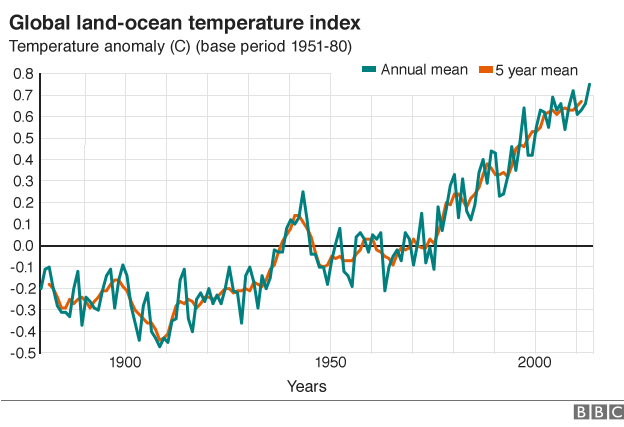From Climate Change to Global Security
French President Francois Hollande opened the World Climate Change Conference 2015 (COP21) at Le Bourget, near Paris, France, November 30, 2015. The Global Climate Summit is abbreviated COP21 (COP stands for Conference of Parties) and this is the 21st, a coming of age for these summits. Soon after the climate change summit launched, a week of heavy flooding struck Chennai, India The local news captures Chennai in a state of emergency.
Photo below – CNN World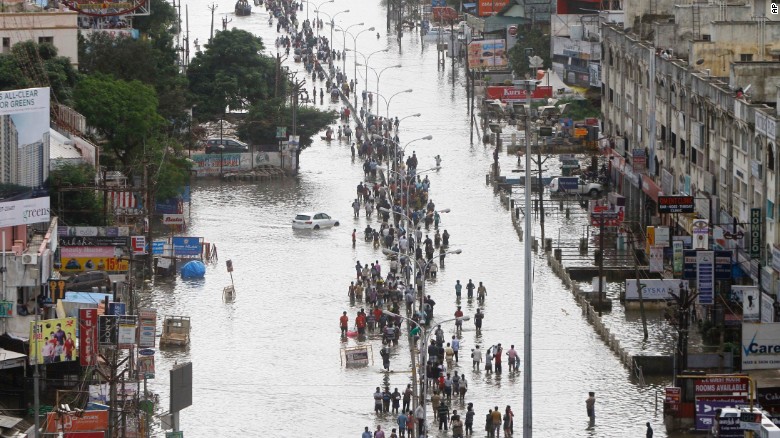
On Sunday, December 6, 2015 Pope Francis prayed at the Vatican for the success of the Global Climate Summit in Paris.
On Monday December 7, 2015 Beijing issued a Red Alert , the first ever, because the level of air pollution had risen higher than 250 — 10 times higher than World Health Organization recommended air quality index. The contrast of the polluted condition with a normal day is captured in photos. In China, despite frequent heavy pollution, life goes on, as captured in this photo of a wedding in China Today. Will weddings in gas masks be the new normal? China is now the world leader in emissions, responsible for 27% of the global total. Emissions are a critical link between local pollution and global warming.
On Tuesday December 8, 2015 the Pope launched the fifth Extraordinary Jubilee held in the past 500 years, which will last through November 2016, dedicated to promoting mercy. The Pope’s encyclical, released in June, was a call to action for delegates at COP21 to come up with an agreement. For the pontiff, the priority of his papacy is fighting climate change.
Question
195 countries came together to produce a plan to limit global warming to no more than 2 degree Celsius, or 3.6 degrees Fahrenheit. But. . . what is the science behind the commitments that need to be met to keep global temperatures from rising more than 2 degrees Celsius?
Threat
Temperatures have thus far risen less than one degree, and we’re already experiencing fearsome hurricanes, drought, tornadoes, forest fires, El Nino, storm surge precursors of sea level rise, potential water and food shortages, huge climate refugee challenges – effects so dire at less than one degree that we cannot possibly conceive of how the complex system of secondary effects, intertwined and co-dependent, will interact at more than double the temperature rise that we’ve seen thus far – 2 degrees Celsius temperature rise. Island nations expect their homes to be flooded if the world warms more than 1.5 C, so they will all be refugees from nations under water with complex ramifications and costs. And limiting temperature rise to 2 degrees C. is presented as the optimum — a best case scenario, a desirable alternative to three or four degrees temperature rise, which some predict is far more likely.
We have traditionally linked Global Warming to increasing greenhouse gases in Earth’s atmosphere (CO2, methane, nitrous oxide, others), which block ultraviolet light from escaping Earth’s atmosphere to outer space and retain it as infrared (heat). However, reversing the many co-dependent loops that together cause climate change may be far more complex than a simple reduction of greenhouse gases in Earth’s atmosphere, more complex scientifically, politically, and economically. Local conditions (floods in Chennai; pollution in Beijing) trigger broader effects that ultimately have global consequences.
Photo of Chennai – National Tamil Daily
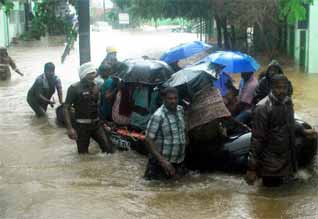 Recall how business argued against abolishing slavery in the mid-nineteenth century, “Our economy depends on slaves. Our economy and society will collapse if we abolish slavery.” Although this sounds ludicrous today, it echoes in industry and national resistance to serious action to reduce climate change.
Recall how business argued against abolishing slavery in the mid-nineteenth century, “Our economy depends on slaves. Our economy and society will collapse if we abolish slavery.” Although this sounds ludicrous today, it echoes in industry and national resistance to serious action to reduce climate change.
At COP21 fine words are exchanged, but behind this “everything is fine” façade lies enormous complexity. The reality is far from simple, but is there a simple takeaway? Separation of the science of climate change from the real politics of power is impossible. Nation states are no more powerful in the face of climate change than in the face of any other threat. Corporations wield power – the fate of spaceship Earth may be up to them to control.
Buckminster Fuller’s World Game is remembered as a learning tool to enable groups to address complex problem-solving for sustainability. Most have forgotten that it was originally called the World Peace Game: Fuller wisely anticipated, more than half a century ago, that the distribution of resources (food, water) would be entwined with keeping the peace. More recently, the evolution of this concept has been the focus of John Hunter’s life work and the interactive media for learning he has produced by teaching the World Peace Game in the classroom for thirty years.
Global Climate Change is forcing us to come to grips with a Gordian Knot: Climate Change and Conflict may march hand in hand, when millions of refugees flee rising tides, when storms destroy infrastructure, when flooding threatens property values, and when the secondary effects of climate change make food and water into luxuries for the rich. Emissions of carbon dioxide from fossil fuels and industry are likely to have fallen 0.6% in 2015, but they increased by around the same amount in 2014. We’re slipping even as repeated crises demand action and the United States has Republican Presidential hopeful Ted Cruz denies that manmade climate change exists. NASA Climate Scientist James Hansen warned the public in 1988 about the grave risk of climate change and was silenced. NASA (the US National Aeronautics and Space Administration) and the EPA (US Environmental Protection Agency) have online sites to educate the public about climate change , but Hansen thinks that it’s too little, and too late.
Complex Systems
Climate Change impinges on every area of our lives, from national security to health and disease control, from financial systems to energy and manufacturing. The Center for Disease Control examines the impact of climate change on human health. And beyond human health, the health of all living systems on the planet is affected.
Chart – Center for Disease Control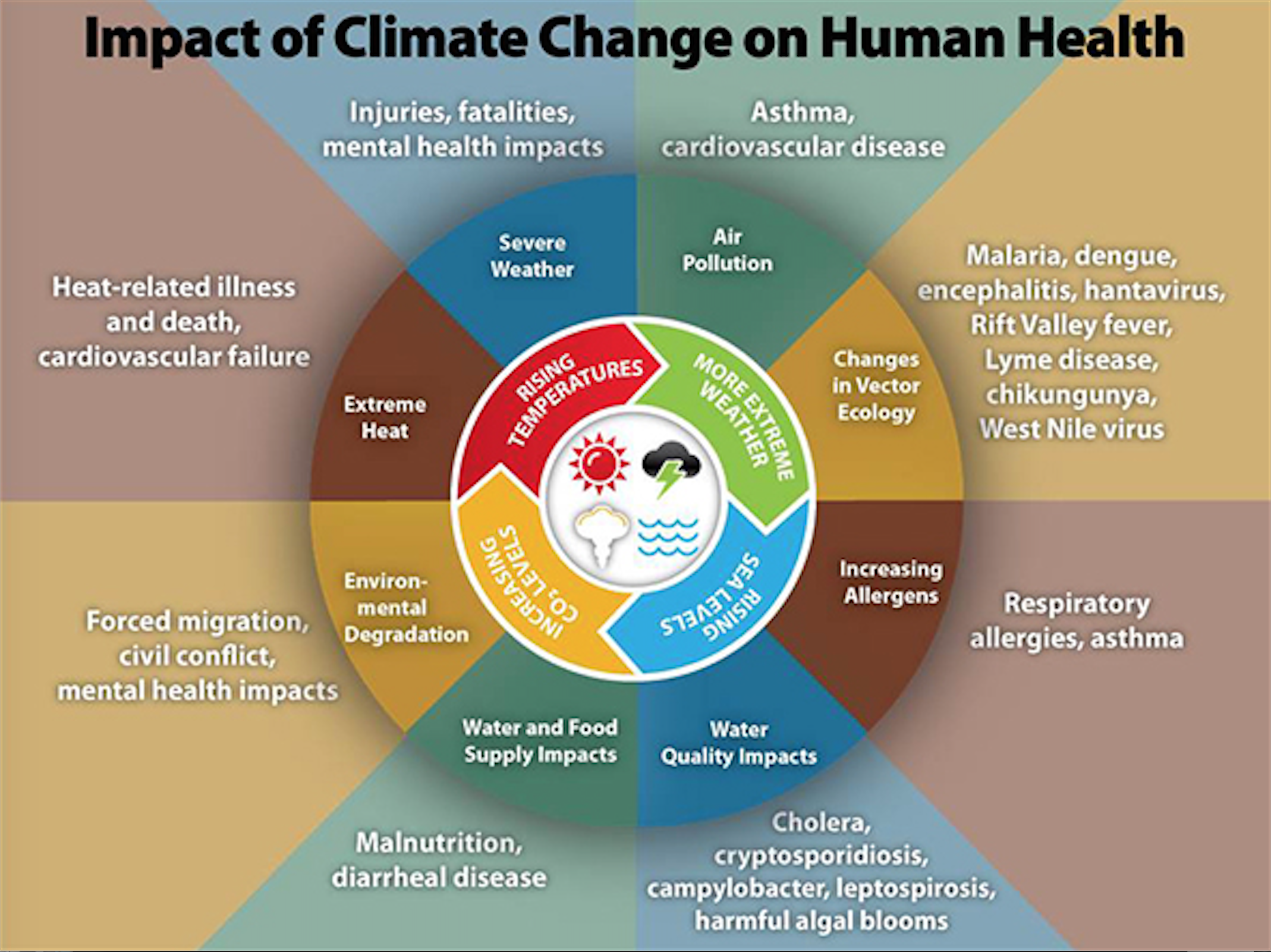
COP21 Process
Nations make pledges about what each nation is willing to commit to do, their so-called Intended Nationally Determined Contributions (INDCs), a complex way of saying that their commitments to address climate change are voluntary, and non-negotiable. No negotiation, and there are still disagreements over whether the sealed deal will be legally binding or optional to comply. Who will monitor? Nation states cannot monitor each other. Shall we entrust a tribunal of corporate representatives to monitor our success at meeting climate standards? Ultimately the challenge goes beyond climate change to global security. With the ink barely dry on the Paris Agreement, 22,000 scientists flew from all parts of the world participated in the annual American Geophysical Union Conference in San Francisco December 14 – 18 acheter cialis generique belgique. Assessing the success of the Paris talks was a a core topic, summed up by Al Gore in his keynote at the conference as “better than we expected.”
Resources
Why should we care about climate change? [BBC]
Current Opinions in Environmental Sustainability (COSUST) Virtual Special Issue: Climate Change.
Conference
COP21 Paris
Conference website
Why does the Paris conference matter?
Draft Paris Outcome
Learning About Climate Change
How Global Warming Works [kept simple] Professor Michael Ranney, UC Berkeley
BBC: What is climate change?
Six BBC Charts that Explain Climate
Background
Synthesis report by the Intergovernmental Panel on Climate Change (IPCC)
BBC – COP21: Carbon emissions ‘to stall or even decline’ this year (12/7/15)
BBC News – Climate Change Special Report
Latest from BBC environment correspondent Matt McGrath
Journal Nature Climate Change
Connect4Climate
United Nations
United Nations Framework on Climate Change
UNFCCC Newsroom
Lima-Paris Action Agenda
Momentum for Change
NAZCA portal
UN Environment Programme Emissions Gap Report (2015)
Adaptation
Report on Enhancing Coherent Action on Adaptation
National Adaptation Plans (NAPs) & Overview of the Adaptation Committee
Financial
Climate Change Guide for Investors
Trends in Private Sector Climate Finance Report
The New Climate Economy Report
Shock Waves: Managing the Impacts of Climate Change on Poverty (World Bank)
The Human Cost of Weather Related Disasters (UN Office for Disaster Risk Reduction)

